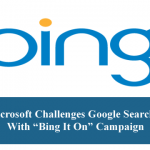
Redmond, Washington — In a latest move to further energize their association, Microsoft has taken a fresh initiative to rebrand its advertising arm as part of a deeper partnership with search firm Yahoo. Under the process, the two tech titans have announced the Yahoo Bing Network as the official name for their combined search marketplace, according to a Microsoft blog post.
Similarly, part of that announcement is that Bing Ads will now supersede the Microsoft’s search ad platform formerly known as adCenter, which has already been launched on the adCenter landing page.
In general, the functionality and advertising network seems to be unchanged. Rather, this seems to be just a re-branding of the network. Bing Ads, like adCenter, will be offered to businesses wishing to place advertisements in search results, or what will now be known as the Yahoo Bing Network.

Elaborating on the nifty features, the company said, “Bing Ads is not only a new name, but an improved experience with new attributes to help you better manage your campaigns and accomplish tasks faster,” says Microsoft’s Tina Kelleher. “Recent improvements include: a new web interface, improved ad rotation controls, and agency enablement tools that make it easier for agencies to manage multiple accounts.”
As a matter of fact, both have mentioned that Internet marketing professionals could potentially reach around 46 million unique US users – that are not using rival search engine, Google – on their search engines. According to comScore’s search engine rankings for July (2012), Bing and Yahoo held approximately just below 29 per cent of the search market.
In a joint statement, they said: “A corresponding result holds true worldwide, with 489 million unique searchers, 92 million of whom do not use Google; and worldwide the Yahoo! Bing Network represents an audience who is likely to spend 124 per cent more than the average searcher and 78 per cent more than Google searchers worldwide.”
Commenting on Bing Ads, Kelleher stated: “Bing Ads is not only a new name, but an improved experience with new features to facilitate you better manage your campaigns and complete tasks faster.”
“Recent improvements include: A new web interface, improved ad rotation controls, and agency enablement tools that make it easier for agencies to manage multiple accounts,” she added.
Besides, David Pann outlines the changes as:
-
Historic Quality Score: Helps advertisers closely monitor their campaign performance trend and proactively respond to the competition.
-
Negative Keywords Conflicts Report: Allows advertisers to identify negative keywords conflicts in scale with ease. As a result, advertisers will receive more targeted traffic and increase their ROI.
-
Share of Voice: Reporting quantifies missed impressions and classifies them in detailed buckets, allowing advertisers to take precise action to regain lost share.
-
Ad Delivery Status and Ad Preview Tools: Enable advertisers to more quickly identify issues hindering ad serving at the campaign, ad group and keyword levels.
-
With ongoing enhancements to the Bing Ads Desktop tool, advertisers have an additional resource for tracking performance and identifying growth opportunities.
-
The Bing Ads Intelligence Tool: Provides access to customizable marketplace level information that allows advertisers to make proactive decisions regarding their campaign management.
Additionally, Pann also mentioned that there is a new Import Campaign feature (for importing from AdWords), and a new Editorial Exceptions feature for resolving editorial disapprovals during and after the ad submission process.
“In addition to Yahoo! and Microsoft Core Search sites, the Yahoo! Bing Network represents partner sites like Facebook, Amazon, Monster, WebMD, CNBC, and Viacom, plus networks like The Wall Street Journal Digital Network,” the companies add.
Going froward, advertisers would do well to note that Bing has just been selected as the default search on Amazon’s new line of Kindle Fire devices.


